15 July 2020
Book report
A few recent reads, reviewed:
 Record of a Spaceborn Few, by Becky Chambers
Record of a Spaceborn Few, by Becky Chambers
The third science fiction novel in the Wayfarers series, this piece examines the culture of the Exodus Fleet, a group of big spaceships that contain most of the human population of Earth, running their own society with a principle idea being that they run a self-sufficient operation, meeting the needs of their populace in place, and running a closed ecological loop, recycling the dead to make soil, to grow new food to feed the living. As with Chambers’ previous books in the series, the beauty and delight of the novel comes in its explorations of character, with a brand new cast of people, most of them human, thinking about what it means to be human when you live in a human society that’s not on its planet of origin. As with A Closed and Common Orbit, the second novel in the series, I missed the plethora of aliens described in such fun Star Wars-level of detail in the original book, The Long Way to a Small, Angry Planet, but at this point I’m hooked on Chamber’s realization of a diverse, inclusive future for our flawed species, and there’s just enough alien in there to keep it spicy.
The Sparrow, by Mary Doria Russell
 A novel of interplanetary civilizations meeting, but also a novel about humans’ spiritual connection to the cosmos. The set up is that an astronomer discovers a signal from another species, living on a planet near Alpha Centauri. He shares the information with his friends, one of whom is a Jesuit priest. The Jesuit communicates the finding to his superiors, and they bankroll a modern “mission” to the planet, to explore God’s creation in the same way the Jesuits sent themselves into some of the more remote corners of the Earth. The assembled team includes both the ecclesiastical crew (three more priests get added in) as well as the circle of the astronomer’s friends, many of whom have much deeper levels of character development than him. At the center is Emilio Sandoz, the priest who feels a calling from God to engage on this journey. The novel is told in alternating chapters: both the “real-time” story unfolding on Earth, within an asteroid that they retrofit as a spaceship, and on the distant planet, which we learn is called Rakhat as well as the story told in reflection and interrogation, forty Earth years later, as Sandoz returns to Earth and Rome, and is asked to explain why everyone else is dead, and what happened to his hands (stretched out into uselessly elongated form) and why his spirit is broken. It’s a powerfully written novel, with many strong characters, thoughtful explorations on our place in the universe, and the trauma of violence on our lives.
A novel of interplanetary civilizations meeting, but also a novel about humans’ spiritual connection to the cosmos. The set up is that an astronomer discovers a signal from another species, living on a planet near Alpha Centauri. He shares the information with his friends, one of whom is a Jesuit priest. The Jesuit communicates the finding to his superiors, and they bankroll a modern “mission” to the planet, to explore God’s creation in the same way the Jesuits sent themselves into some of the more remote corners of the Earth. The assembled team includes both the ecclesiastical crew (three more priests get added in) as well as the circle of the astronomer’s friends, many of whom have much deeper levels of character development than him. At the center is Emilio Sandoz, the priest who feels a calling from God to engage on this journey. The novel is told in alternating chapters: both the “real-time” story unfolding on Earth, within an asteroid that they retrofit as a spaceship, and on the distant planet, which we learn is called Rakhat as well as the story told in reflection and interrogation, forty Earth years later, as Sandoz returns to Earth and Rome, and is asked to explain why everyone else is dead, and what happened to his hands (stretched out into uselessly elongated form) and why his spirit is broken. It’s a powerfully written novel, with many strong characters, thoughtful explorations on our place in the universe, and the trauma of violence on our lives.
 The Two-Mile Time Machine, by Richard Alley
The Two-Mile Time Machine, by Richard Alley
Penn State glaciologist/climatologist Richard Alley wrote this book as a popular account of his scientific work decoding past climatic variation (including abrupt climate change) from ice core data, particularly from Greenland. It’s an account of the how and the why of drilling through the Greenland ice sheet for information about the past, and how that ice sheet formed. The latter half of the book is a description of what that ice core information has revealed about the past few million years of climate history on our planet. In particular, focus is given to the North Atlantic, and changes in oceanic circulation that result in changes to sedimentation and isotopes. The great strength of Alley’s writing (and his general science communication) are his imaginative analogies, which feature many more hits than misses, and force the reader to think about Earth processes from a fresh perspective. Reading this has been on my list of things to do for years; I’m glad to finally have managed to make it happen.
 Lone Traveller, by Anne Mustoe
Lone Traveller, by Anne Mustoe
This is a “bicycling around the world” travel book (a favorite genre of mine) but it’s not structured as a “first I went here; then I went there, and finally I made to this other place,” as she did with her breakout travelogue, A Bike Ride. Instead, the structure of this book is thematic: what she packed, how she dealt with bureaucrats, how she found shelter, how she dealt with wild animals and predatory men. As such, it’s more like a conversation over tea with the protagonist, when a prompt leads to a series of anecdotes connected by a common thread: “But tell me, weren’t you ever scared?” “Well, there was this time in China when…” etc. In book form, I’m not sure it works as elegantly as in spoken conversation; I like my books to have a narrative arc to them, and the structure of a travelogue is familiar and uncomplicated and comfortable, but I can also appreciate why as an author Mustoe made the call to organize things differently. I’m sure it was more engaging to write for her when the vast year+ of experiences in the world were considered in terms of notable lessons that cluster around the most common queries an experienced traveler gets from those who are curious about exploring the world as a solitary woman.
 Binti, by Nnedi Okorafor
Binti, by Nnedi Okorafor
A novella set in the future about a Himba girl (from what is today Namibia or Angola), who scores well on an exam and gets a free ride to the galaxy’s best university, but she has to leave her family and home to go. She retains an important practice from her culture: the use of otjize, a mix of oil and clay that is kneaded into the hair and spread over the skin. This traditional practice is a soulful connection to her sense of self, despite her nontraditional path – but it also acts as a shield against envenomation by jellyfish-like aliens that attack her “schoolbus” ship as it crosses interstellar space. Binti also brings with her an object she found in the desert back home, which turns out to allow her to translate the medusae’s language, something no other human has been able to do. This puts a unique person into a unique position in the history of the galaxy. Is Binti up to the task? She is.
10 July 2020
Friday fold: Candigliano River, Italy
Reader Michael Hiteshaw spotted some amazing folds this week while watching Kayak Session TV on YouTube.
Though there’s a dramatic arc of “saving” a deer, both Michael and I felt our eyes drawn to the canyon walls where there are gorgeous folds in several sizes and shapes, with an emphasis on chevron folds:
The video description on YouTube reads:
19 June 2020
Friday fold: Scaglia Rossa chevrons at Lago di Fiastra
My friend Alan Pitts is orchestrating a virtual field camp for George Mason University this summer, utilizing outcrops in central Italy’s Apennine Mountains. Here’s a 3D model he just posted of one of the most impressive outcrops there: the chevron folds in the Scaglia Rossa limestones at Lago di Fiastra. I featured the site as a Friday fold 3 years ago when Alan took me there in person, but this gives a much fuller picture of the site:
5 June 2020
Friday fold: Harbledown Island
Reader Christian Gronau writes with this Friday fold contribution:
Greetings from Cortes Island, BC – at the opposite end of the Strait vis-a-vis Lopez Island.
Your Mountain Beltway blog is always of interest, and I have been following it for several years by now. Thank you for putting the effort into this worthwhile website.
Quite regularly your posts elicit “echoes” and make me go back to some of my own geological notes and photographs. The Lopez Island tension gashes are exquisite in their elegance and classic simplicity.
A little further north again from Cortes Island lies Harbledown Island, eponymous of the Harbledown Formation (Early Jurassic sediments, often fossiliferous). The west of the island has a bay called Parson Bay, eponymous of the Parson Bay Formation (Late Triassic, also fossiliferous) – making this geographical area one of rare distinction as well as historical complexity (early 20th century stratigraphic work).
The attached photograph shows part of an extensive stress zone in Parson Bay limy shales, looking remarkably similar to the image of your last “Friday Fold,” though a bit more complex and, perhaps, confusing. I thought you might be interested in seeing it:
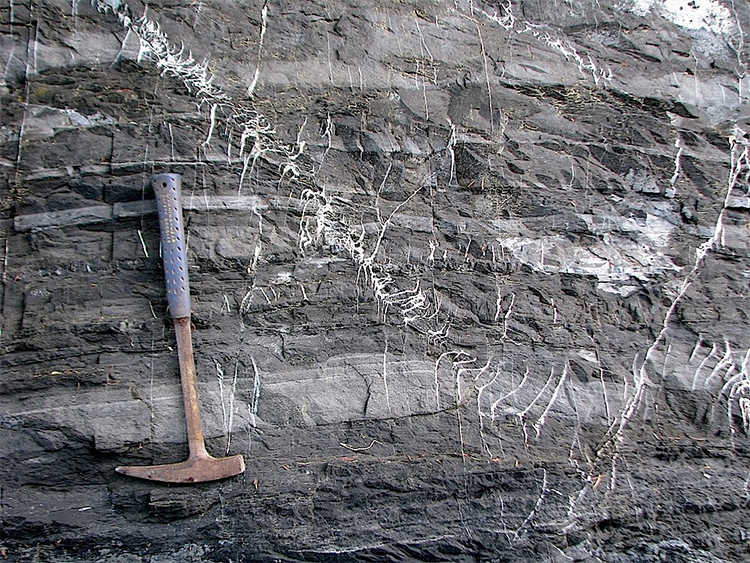
That’s a lovely outcrop photo, Christian! It has many of my favorite features: a multi-chapter story (i.e., it’s a palimpsest rock), good structural geology, a well-placed sense of scale, and a lack of vegetation, barnacles, and/or anthropogenic detritus. A very pleasing sight to contemplate at the end of a rough week.
29 May 2020
Friday fold: Lopez Island tension gashes
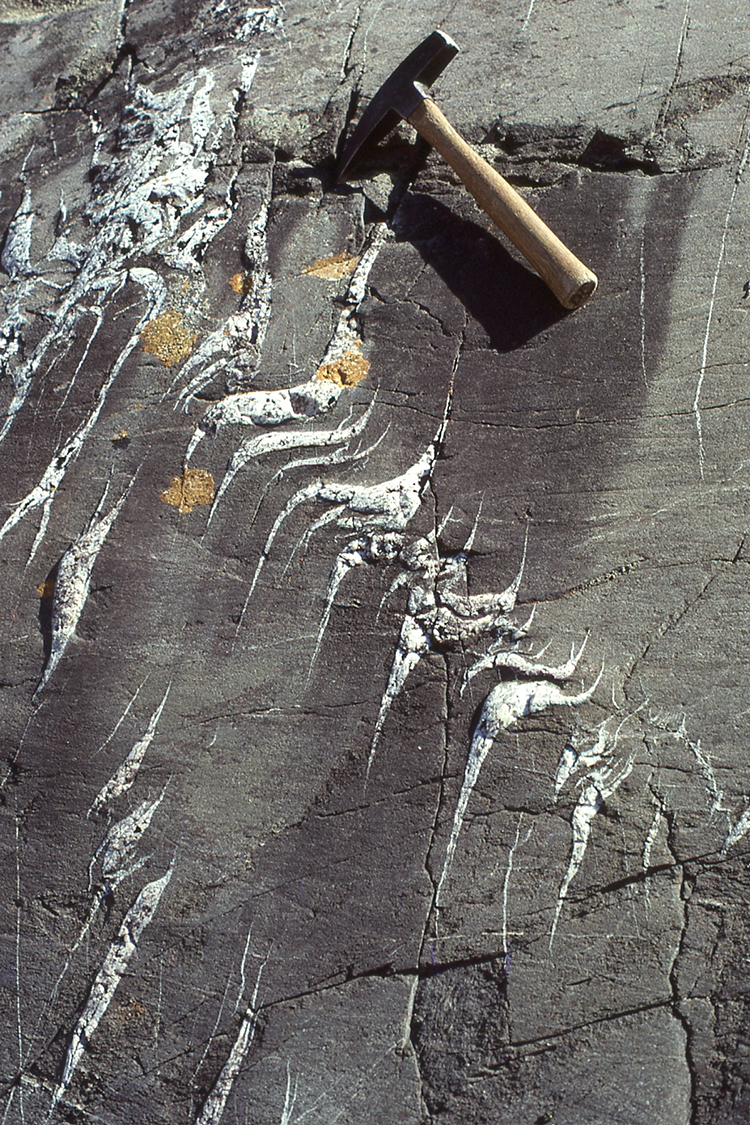
Darrel Cowan returns with a Friday fold for you! He writes with these
awesome fractures. They formed in slightly metamorphosed sandstone on Lopez Island in the San Juan Islands, Washington. The rocks are probably Late Jurassic-Early Cretaceous in age and part of the Lopez Structural Complex [I can give a reference for the setting: GSA SP 221]. The sandstone exhibits a weak foliation imparted by dissolution and reprecipitation of quartz; the quartz in the fractures is evidence of the role of fluids.
You can interpret what we see. I tell my students that these formed in a localized shear zone, even if the boundaries are not expressed in the outcrop, which is glacially polished and striated, by the way. I challenge my students to infer the sense of shear and to explain why the fractures are sigmoidal and thicker in the middle [they kept opening while rotating and extending their wings outward!]. The youngest tips are oriented at 45° to the boundaries of the shear zone, as predicted.
I’ve wanted to go back and visit these outcrops, but access on Lopez is extremely difficult. Someday, after covid-19.
Best wishes to all. On several levels, the Friday fold feels like a frivolous indulgence in such dark times for the nation, but perhaps its a reminder of the sort of content that acts as a beacon of normalcy. It’s the content I would prefer to focus on, were pandemic disease, racial injustice, culture war, environmental degradation, and looming facist oppression not occupying my thinking instead.
22 May 2020
Friday fold: Anticline in Glacier National Park
Working on a virtual field experience for Glacier National Park this weekend, I came across this amazing GigaPan of a portion of central Glacier by Joe Giersch of the USGS:
What really struck me about it is that big arc of white rock (quartzite, no doubt) within the lower green argillites of the Appekunny Formation… Just left of center. Zoom in and see if you can find it!
I saw that and thought, “Ooh! A fold!” But then I thought that perhaps it was just a trick of the outcrop: i.e. a curved landscape intersection a planar bed, as in the false syncline I noted in Titus Canyon. To corroborate, I looked to adjoining ridges. And…sure enough, it can also be seen in the next ridge over to the right, highlighted by vegetation.
I found the place in Google Maps, and shifted the perspective so I was looking along strike of the anticline’s axis:
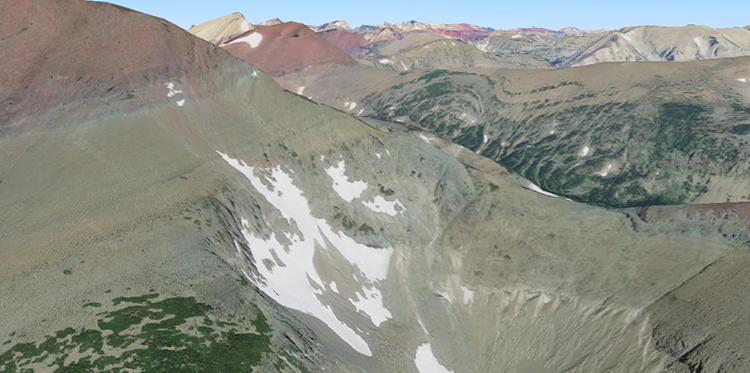
Because the fold trends north-northwest, and the valleys run east-west, you can see it appearing in cross section on at least three ridges there! Here’s a link on Google Maps to get this same view, should you care to poke around there yourself.
Sure enough, on the Whipple (1992) geologic map of the park, there’s an anticline mapped at that location:
A little virtual geological discovery for me… What an amazing place; I miss it pangfully.
15 May 2020
Friday fold: Argentinian turbidites
Zoltán Sylvester brings us this Friday’s fold:

And there’s more where that came from:


These are deepwater strata of the Lower Cretaceous Rio Mayer Formation, exposed near Lago Argentino, Argentina, south of the lake’s northwest “arm,” about here. They were deformed so exquisitely during Andean mountain-building.
Zoltán is a talented photographer, and you should check out more of his work here.
8 May 2020
Friday fold: Wills Mountain Anticline
Eric Fulmer (who pitched in with last week’s Friday fold) returns this week with another treasure. He writes,
I was in Hopeville, WV a couple of years ago. The entire area between Cabins and Hopeville is a real joy (geologically and recreationally) as some of the most resistant rocks of the Mid-Atlantic Appalachians are folded and exposed in quick succession and with great relief. I am particularly fond of seeing the western-most exposure of Tuscarora Sandstone in the Wills Mountain Anticline along the North Fork Gap.
The Wills Mountain Anticline is a much larger structure than the Hopeville Anticline and the most obvious member of the antiform is the resistant Tuscarora Sandstone. North Fork Mountain (south of North Fork Gap) is essentially the eastern limb of the anticline and resistant Tuscarora forms white cliffs along the crest of the mountain for miles. The western limb of the anticline includes nearly vertical beds of the same unit plunging directly into the earth; Seneca Rocks are equivalent rocks further to the south.

Click to enlarge

Click to enlarge
The best view that I have seen of the Wills Mountain Anticline is from the first ridge of North Fork Mountain Trail (northern trailhead). The path winds up the mountain and then takes you to a fabulous viewpoint across the North Fork Gap towards New Creek Mountain, where the Tuscarora Sandstone can be followed from east to west across the entire anticline. The drop into the gap is also quite dramatic for the East Coast.
Highly recommended for a long day trip or overnighter.
Once again, thanks to Eric for contributing a fold. Other readers are welcome to do the same. Just drop me an email.
6 May 2020
The Broken Land, by Frank L. DeCourten
 You might think that the last two months would have been a good time for reading, given the social isolation and stay-at-home orders. But that hasn’t worked out to be the case for me. The stresses of the pandemic, new and different work responsibilities, new homeschooling responsibilities, ongoing textbook writing and an impending move for my family have all conspired to gobble up my time, and there’s been very little time left over for reading books. I managed perhaps 2 or 3 pages per day. I started Frank DeCourten’s The Broken Land before I went to Death Valley in early March. But I didn’t finish it until this morning. It was good. It’s a comprehensive summary of Great Basin (Basin & Range) geology: outcrops, locations, events, and interpretations, accompanied by anecdotes and DeCourten’s own hand-sketched illustrations. I found it an excellent compilation, and I’ll keep it on my shelf for the rest of my career, for the next time (hopefully) that I’m lucky enough to return to the Basin & Range. One distinctive aspect to the book is that each chapter opens with a personal story about some experience DeCourten has had on a geological field trip. These are an attempt to draw the reader in toward the experience of geological explorations in the area. I found them familiar enough and therefore engaging, but I’m increasingly conscious that they may not appeal to everyone – they are the experiences of a able-bodied white male professor, and I wonder how they would land with any other audience. Unfortunately, I’m the wrong person to make that call. My gut tells me that the book would have been stronger without them, though. Overall, the geological content is solid and comprehensive and useful. It’s a valuable resource for anyone seeking a better understanding of how the Basin & Range came to be.
You might think that the last two months would have been a good time for reading, given the social isolation and stay-at-home orders. But that hasn’t worked out to be the case for me. The stresses of the pandemic, new and different work responsibilities, new homeschooling responsibilities, ongoing textbook writing and an impending move for my family have all conspired to gobble up my time, and there’s been very little time left over for reading books. I managed perhaps 2 or 3 pages per day. I started Frank DeCourten’s The Broken Land before I went to Death Valley in early March. But I didn’t finish it until this morning. It was good. It’s a comprehensive summary of Great Basin (Basin & Range) geology: outcrops, locations, events, and interpretations, accompanied by anecdotes and DeCourten’s own hand-sketched illustrations. I found it an excellent compilation, and I’ll keep it on my shelf for the rest of my career, for the next time (hopefully) that I’m lucky enough to return to the Basin & Range. One distinctive aspect to the book is that each chapter opens with a personal story about some experience DeCourten has had on a geological field trip. These are an attempt to draw the reader in toward the experience of geological explorations in the area. I found them familiar enough and therefore engaging, but I’m increasingly conscious that they may not appeal to everyone – they are the experiences of a able-bodied white male professor, and I wonder how they would land with any other audience. Unfortunately, I’m the wrong person to make that call. My gut tells me that the book would have been stronger without them, though. Overall, the geological content is solid and comprehensive and useful. It’s a valuable resource for anyone seeking a better understanding of how the Basin & Range came to be.
And now: Onward to the next book! Hopefully I’ll have more reading on which to report before another two months elapse.
1 May 2020
Friday fold: Hopeville Anticline
Reader Eric Fulmer has contributed a fold as a balm for the end of another week of COVID-19 self-quarantine. Check it out:
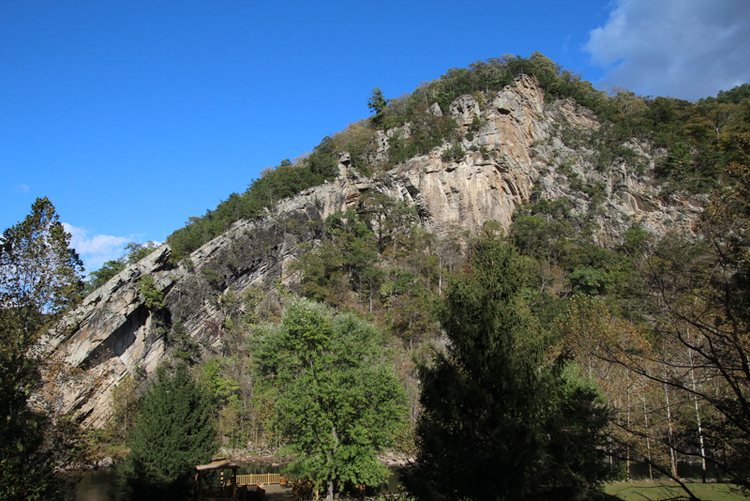
Eric writes,
I was in Hopeville, WV a couple of years ago. The entire area between Cabins and Hopeville is a real joy (geologically and recreationally) as some of the most resistant rocks of the Mid-Atlantic Appalachians are folded and exposed in quick succession and with great relief. I am particularly fond of seeing the western-most exposure of Tuscarora Sandstone in the Wills Mountain Anticline along the North Fork Gap. Immediately next to Hopeville (Harman’s Cabins, just off of WV-55), a textbook anticline of Oriskany Sandstone is exposed where the “North Fork of the South Branch of the Potomac” cuts through the Hopeville Anticline. The hinge line is high up the hill side and the western limb plunges into the earth at a ~35 degree angle. The competent sandstone forms a nice cliff face and exposes easy to identify bedding layers across the outcrop. Decent views of the entire anticline can be found from the Cabins Assembly of God upper parking lot.
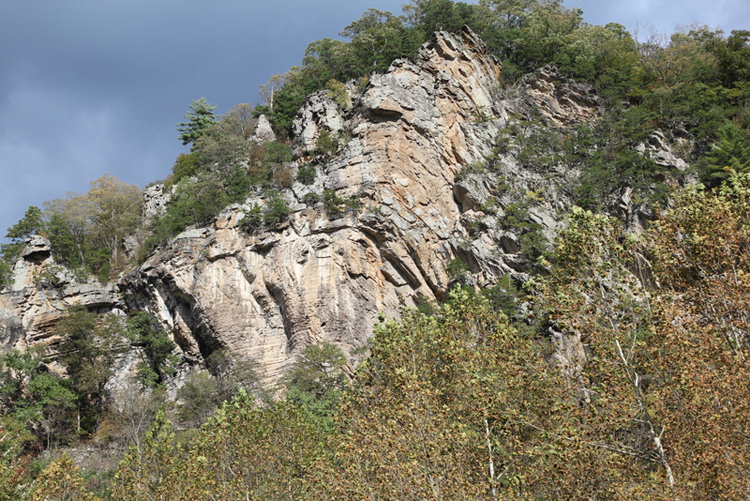
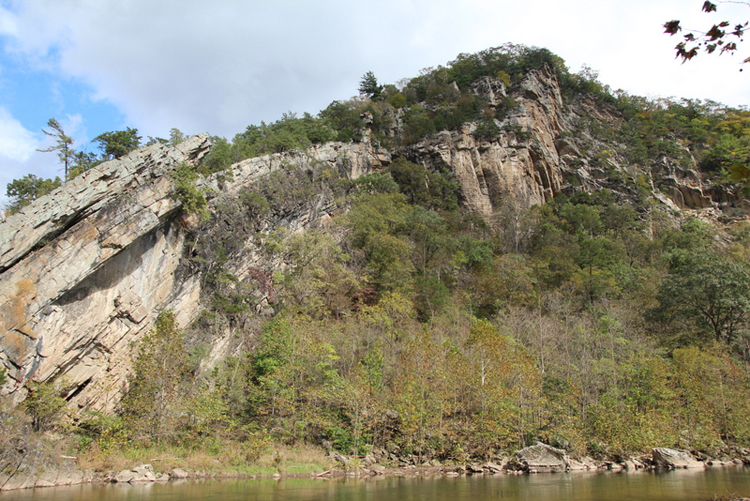
Thanks Eric!
Happy Friday to all.


 Callan Bentley is Associate Professor of Geology at Piedmont Virginia Community College in Charlottesville, Virginia. He is a Fellow of the Geological Society of America. For his work on this blog, the National Association of Geoscience Teachers recognized him with the James Shea Award. He has also won the Outstanding Faculty Award from the State Council on Higher Education in Virginia, and the Biggs Award for Excellence in Geoscience Teaching from the Geoscience Education Division of the Geological Society of America. In previous years, Callan served as a contributing editor at EARTH magazine, President of the Geological Society of Washington and President the Geo2YC division of NAGT.
Callan Bentley is Associate Professor of Geology at Piedmont Virginia Community College in Charlottesville, Virginia. He is a Fellow of the Geological Society of America. For his work on this blog, the National Association of Geoscience Teachers recognized him with the James Shea Award. He has also won the Outstanding Faculty Award from the State Council on Higher Education in Virginia, and the Biggs Award for Excellence in Geoscience Teaching from the Geoscience Education Division of the Geological Society of America. In previous years, Callan served as a contributing editor at EARTH magazine, President of the Geological Society of Washington and President the Geo2YC division of NAGT.